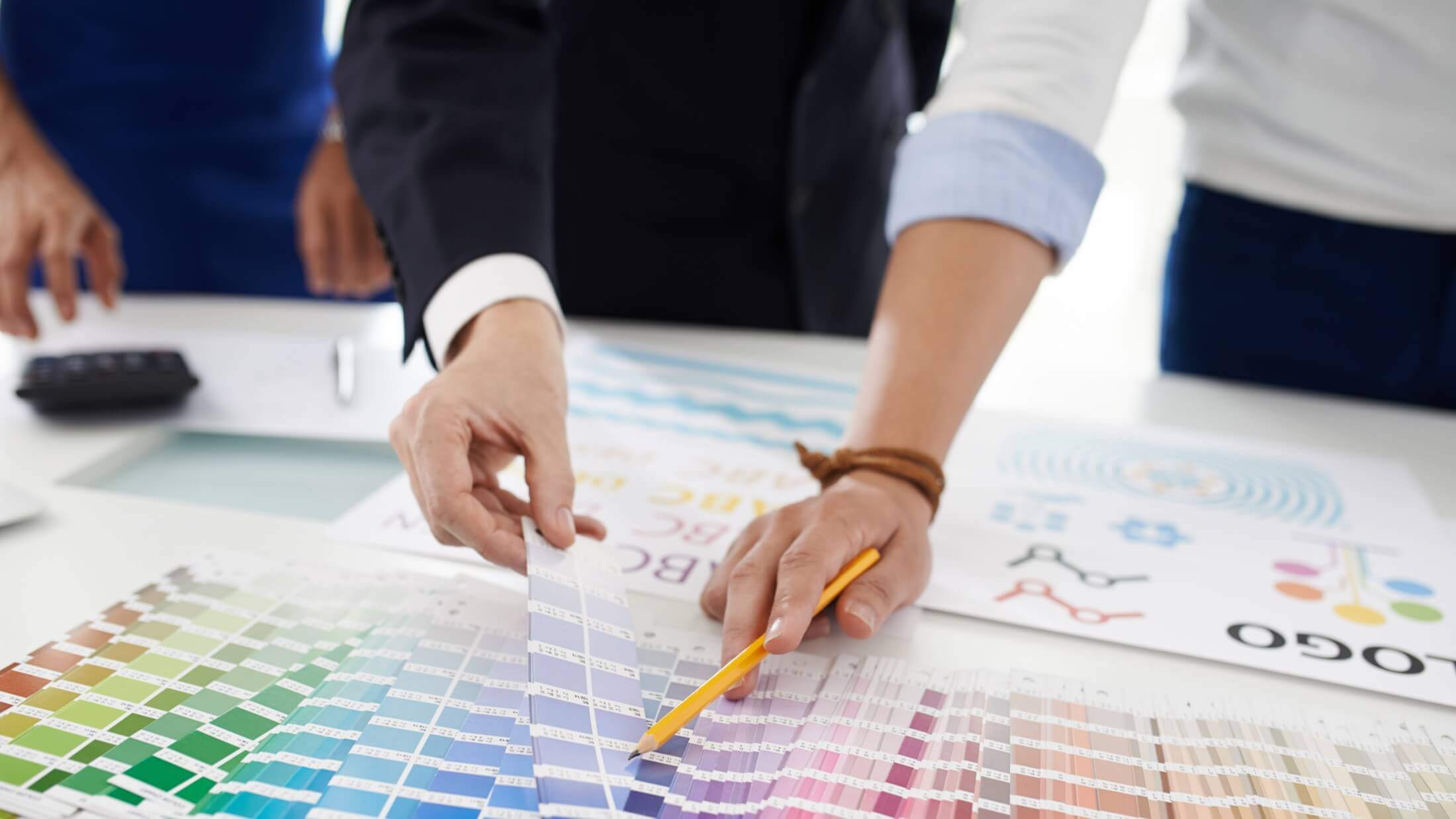What’s a brand design system, and why is it the linchpin of brand identity? Simply put, it’s your brand’s visual DNA, replicated consistently across every platform to resonate with your audience. This guide unpacks the essentials of brand design systems, from color and typography to UI components, demonstrating how these systems empower your branding efforts. Dig into the components, benefits, and step-by-step creation process, enriched with industry leader insights, ensuring your brand not just survives but thrives in the competitive marketplace.
Key takeaways
- Design systems foster a cohesive brand identity through a structured collection of interdependent components such as typography, UI components, and brand values, contributing to accelerated growth and enhanced user experience.
- The maintenance of design systems is critical and requires regular updates, with automated tools such as Chakra UI and Token Studio aiding in keeping the system current and effective for improved efficiency and brand consistency.
- Accessibility is a fundamental aspect of design systems, aiming to create inclusive digital experiences through accessible design elements and integrating accessibility across the brand for a wider audience reach.
The essence of brand design systems
Design systems provide direction for a brand’s design process. They are the glue that binds different elements together to create a consistent brand identity and user experience. If we could visualize a design system, it would resemble a vast, interconnected web, with every strand representing a different component. Some key design system components include:
- Typography
- Color palettes
- UI components
- Brand values
The beauty of a design system lies in its unity; every component is interdependent, contributing to a holistic brand experience.
A design system’s importance is not limited to aesthetics. It’s a testament to a brand’s commitment to its stakeholders and has been correlated with accelerated company growth and revenue enhancement.
Defining a unified brand design system
A unified brand design system is a brand design kit called:
- A shared language for designers and developers
- A comprehensive universe of design elements and guidelines
- Includes functional patterns, perceptual patterns, and standards and documentation that accompany all visual assets
- A design blueprint that defines the principles, rules, and constraints applied in design and code, along with the administrative aspects of operating in a digital environment.
Naming conventions in a design system hold immense importance, as clear, searchable, and consistent names for different categories ensure easy understanding of components, styles, and states. With a clear set of guidelines, a brand design system provides a strong and adaptable framework, encompassing both strict and flexible rules.
The role of reusable components
Design systems resemble Lego kits, comprising reusable components that can be assembled in various ways to create unique structures. In the context of design systems, these ‘Lego blocks’ are the building blocks like:
- Buttons
- Form fields
- Typography
- and more
The magic of this approach lies in its scalability, especially for large organizations with numerous designers and developers working on multiple products. Salesforce’s Kinetics System and IBM’s Carbon Design System are perfect examples of how reusable components can improve efficiency and maintain consistency within the design system.
These systems allow designers to focus on the design aspect and developers to concentrate on the logic aspect, thereby enhancing collaboration and the efficiency of developing reusable components.
The significance of visual consistency
Visual consistency is the key to a design system’s success. It’s like the rhythm in a song, bringing harmony and balance to the design. Consistent visual rules enhance the meaning of visuals and ensure uniformity throughout the brand. Icons, being widely used across different platforms and applications, are crucial in maintaining visual consistency.
When creating illustrations for a design system, factors such as anatomy, style, and color must be considered to ensure they can be scaled and maintain consistency with the overall design language. Achieving a harmonious blend of visuals that align with the brand, serve a practical purpose, and can be easily expanded is a challenge that companies frequently encounter.
Crafting your own design system
Having grasped the basics of design systems, we can now explore the process of creating one. Like building a house, creating a design system starts with a strong foundation — brand guidelines. These guidelines serve as the blueprint, guiding the design and development process and ensuring that the final product is a true reflection of your brand’s vision and values.
Establishing brand guidelines
Creating brand guidelines is akin to charting a course for a journey. These guidelines should encompass:
- A detailed brand narrative
- Logo specifications
- The brand’s vision and values
- Messaging strategies
- Usage guidelines for the logo, color palette, and fonts.
This guidebook not only sets the direction for your design system but also serves as a reference point for all stakeholders, ensuring that everyone is on the same page.
Building blocks of a design system
A design system can be compared to a puzzle, with its building blocks being the individual pieces that fit together to create a comprehensive picture. These building blocks include a comprehensive set of patterns and components, and reusable modular components. Establishing a component library for a design system involves creating an interface inventory, selecting appropriate tools and frameworks, and acquiring necessary components such as atoms and molecules.
These building blocks ensure that the design system is robust, scalable, and flexible, adapting to changing needs and requirements.
Addressing ongoing maintenance issues
Creating a design system is an ongoing process, not a one-time project that requires regular updates and maintenance. Just like a car, a design system needs regular check-ups to ensure it continues to function optimally and stays up-to-date with the latest trends and technologies. Industry experts advise updating a brand design system every 3-5 years to maintain its relevancy.
Tools that can be used for the maintenance of a design system include:
- UXPin
- Zeroheight
- Supernova
- Storybook
Automating the maintenance process can ensure long-term effectiveness, with tools like Chakra UI and Token Studio helping in automating the creation and upkeep of tasks.
Collaboration between designers and developers
Design systems serve as a conduit between design and development teams, fostering a collaborative environment where both designers and developers can work together seamlessly. This collaboration is critical in streamlining the development process and enhancing overall efficiency, with the design team playing a crucial role.
Let’s take a closer look at how Atlassian design system and other design systems facilitate this collaboration.


Streamlining the development process
Consider a factory assembly line where each worker has a distinct role. The efficiency of the line depends on how well each worker performs their task and how seamlessly they work together. Similarly, a design system provides a shared set of guidelines and components for designers and developers, ensuring consistency and efficiency and ultimately saving time and streamlining the overall process.
A design system brings about efficiency improvements in the development process by:
- Significantly enhancing product development
- Boosting efficiency on a large scale
- Enhancing job satisfaction
- Expediting the development timeline
- Enhancing product quality
- Reducing costs
- Providing flexibility to accelerate the development of new features.
By implementing a design system, you can achieve these benefits and create a more efficient and streamlined development process.
Automating the maintenance process with tools such as Chakra UI and Token Studio can enhance the efficiency of the development process.
Enhancing team communication
In the symphony of product development, designers and developers play various instruments, but they both contribute to the symphony of the final product. A design system facilitates clear communication between these two critical players in the product development process. It provides a shared language, making it easier for both teams to understand and work with each other.
Tools such as Adobe Creative Cloud, Figma, Sketch, InVision, and Canva can be used for facilitating effective communication within a design system.
Case studies: Successful brand design systems
Examining real-world examples can help us understand the power and potential of design systems better. Let’s take a closer look at three successful design systems from leading technology companies — Google, IBM, and Apple.
Google Material Design system
Google’s Material Design system is a good example of a design system that replicates the physical world and its textures through its components. It includes design principles such as color, typography, and iconography, along with UI components and code documentation. The theming system of Google Material Design offers a high degree of flexibility, enabling detailed customizations across a wide range of components simultaneously.
Material Studies are hypothetical case studies that illustrate the versatility and comprehensive application of the design system.
IBM carbon design system
The IBM Carbon Design System is another excellent example of a comprehensive design system that covers a wide range of digital experiences. At its core, it includes:
- Colors
- Assets
- Code
- Guidelines
- Various other elements
These are intended to provide a foundation for a wide range of applications. It also provides a wide range of tools and visual assets for designers using Adobe, Axure, and Sketch, as well as for developers.
The core system is intentionally designed to be extensible. It offers frameworks for local systems. The core system can serve as a foundation for creating local systems tailored for specific applications.
Apple’s Human interface guidelines
Apple’s Human interface guidelines reflect the company’s focus on creating an inclusive and accessible user experience. It offers guidelines for the design, development, and distribution of apps across Apple’s platforms. The design system of Apple encompasses:
- Web design essentials
- Pattern libraries
- Downloadable templates
- An iOS UI kit library
- An extensive resource library with files for Sketch, Photoshop, and Adobe XD.
Each section of Apple’s Human interface guidelines provides guidance on:
- App architecture
- User interaction
- System capabilities
- Visual design
Accessibility holds a high level of significance in Apple’s Human interface guidelines, as it is consistently emphasized throughout the guidelines, highlighting its crucial role in all of their products.
Implementing accessibility and inclusion
Design systems go beyond being merely a collection of design elements. They are tools for creating inclusive digital experiences that cater to a diverse user base. One such example is the Microsoft Fluent Design System.
Incorporating accessibility and inclusion in a design system ensures that your product is usable by the widest possible audience.
Creating accessible design elements
Designing accessible components is a crucial aspect of creating an inclusive design system. This involves ensuring that all elements, from color and typography to forms and buttons, are designed in a way that they can be used by everyone, regardless of their abilities or disabilities. This can be achieved by following established accessibility guidelines and principles, such as providing text alternatives for non-text content, enabling keyboard navigation, and using sufficient color contrast.
To ensure accessibility for visually impaired users, colors and color contrast, readable font sizes and weights, alternative text for images, and interfaces at the component level should be considered. For users with hearing impairment, flexible content, summary of audio and video content, and video captioning can improve accessibility. Key accessibility considerations for users with cognitive disabilities include incorporating visual cues to emphasize crucial points or content sections and ensuring sufficient color contrast between text and background elements, as well as for all significant objects on a page.
Keyboard accessibility can be integrated into web design elements by enabling keyboard users to navigate between page sections using the Tab key, Shift+Tab, and Enter.
Integrating accessibility into the brand experience
Integrating accessibility into the brand experience not only makes your product more usable but also communicates to your users that you care about their needs and experiences. This can have a profound impact on your brand’s reputation and can foster loyalty among your users.
For example, companies like:
- Lowe’s
- Unilever
- Apple
- Lego
- Sony PlayStation
- Barbie
… have effectively integrated accessibility into their brand experience. This demonstrates that accessibility is not just about complying with guidelines and standards, but is a core part of a brand’s identity and values.
Measuring the impact of a brand design system
Much like a builder checks the dimensions of a house for accuracy, the effectiveness of a design system should also be evaluated. This involves evaluating user engagement, brand consistency, and other key metrics to assess whether the design system is achieving its intended goals and objectives.
Tracking user engagement
User engagement metrics offer valuable insights into how users are interacting with your design system. These metrics, which include:
- Pageviews
- Sessions
- Users
- Social media engagement
- Branded keywords
- Customer referrals and recommendations
- Repeat customers
- Brand mentions
… can help you gauge the effectiveness of your design system. Tools such as Hotjar and Appcues can be used to effectively monitor user engagement.
When users establish emotional connections with a brand and have favorable experiences with its design system, it can result in heightened loyalty, customer satisfaction, and user retention.
Evaluating brand consistency
As discussed earlier, brand consistency is a key aspect of a successful design system. It involves ensuring that your brand’s message is consistent across all touchpoints, including:
- Your website
- Social media platforms
- Marketing materials
- Customer service interactions
Some tools that can be used for assessing brand consistency are:
- Adobe Creative Cloud
- Figma
- Sketch
- InVision
- Canva
Consistency not only helps establish brand recognition and trust with users but also streamlines the design process, saving time and effort.
Leveraging design systems for marketing success
An expertly constructed design system can significantly contribute to marketing success. By ensuring consistency and cohesiveness across all marketing materials, a design system can enhance brand recognition, foster customer loyalty, and ultimately drive business growth.
Aligning brand personality and campaigns
A design system helps to create a consistent brand personality across marketing efforts. By adhering to the same design principles and guidelines, marketing teams can ensure that all marketing materials reflect the brand’s unique personality and values. This includes:
- Social media posts
- Email campaigns
- Print advertisements
- Billboards
By maintaining consistency in design, the brand can establish a strong and recognizable presence in the market.
Enhancing data visualization in marketing
Data visualization is a powerful tool for presenting complex data in a simple and understandable way. By leveraging the principles and guidelines of a design system, marketers can create visually appealing and easy-to-understand data visualizations that effectively convey their message.
The use of design systems in data visualization can enhance understanding and involvement with data visualizations by offering a collection of reusable components and behaviors that improve consistency, efficiency, usability, and functionality.
Essential elements of a robust design system
Similar to the need for a solid foundation for a building to stand tall, a design system requires key features for success. Let’s explore some of these essential elements.
Scalability and flexibility
A successful design system is both scalable and flexible. It should be able to accommodate growth – whether that’s adding new features, expanding to new platforms, or adapting to changing user needs. Scalability ensures a consistent user experience regardless of the number of users accessing the app, and enhances efficiency by maximizing reuse and minimizing rework in the design process.
Flexibility, on the other hand, ensures that the design system can adapt to changing needs and requirements. By prioritizing the core elements that remain consistent, such as the logo and color, and developing adaptable components like fonts and imagery, a design system can remain flexible and adaptable.
Functional patterns and practical examples
Functional patterns are the behaviors depicted through tangible blocks in a design system. These patterns are more conceptual and develop through iterative processes, offering a collection of reusable components that improve:
- Consistency
- Efficiency
- Usability
- Functionality
Real-world examples of functional patterns in design systems establish the framework of the design, encompassing the backend layout, while perceptual patterns govern the visual aspects, such as typography.


These examples illustrate the advantages of the design system, including expediting product development, fostering uniformity, and ensuring the utilization of appropriate assets and components.
The creation process: From brief to launch
The process of creating a design system mirrors that of building a house, involving a series of steps from establishing the foundation to the final touches.
Let’s walk through this process together.
Gathering input and setting objectives
Just as an architect consults with the homeowner before drawing up plans, gathering stakeholder input is a crucial first step in creating a design system. This input provides a robust framework for innovation and creation, ensuring that the design system aligns with the stakeholders’ goals and objectives.
Clear, measurable objectives should be established for the design system, broken down into smaller milestones to effectively monitor progress and sustain momentum.
Developing style components and grid systems
The next step is to develop the style components and grid systems that will form the core of the design system. Building a catalog of reusable components involves:
- Analyzing the current design process
- Conducting a UI audit
- Researching other design systems
- Listing out components
Establishing a grid system for a design system is essential to offer organization and direction for the arrangement of UI components. It guarantees the alignment and responsive behavior of various visual elements, including:
- Typography
- Columns
- Boxes
- Icons
- Illustrations
Navigating complex systems: A strategy guide
Design systems, with their numerous components and guidelines, might sometimes appear as a complex maze. However, with the right strategies, navigating these systems can become a smooth and efficient process. Effective approaches for navigating complex design systems involve:
- Enabling users to embark on a methodical exploration journey
- Visualizing the system
- Collaborating with engineers
- Emphasizing the intention
- Presenting design or research to non-experts
- Leveraging the expertise of others
Summary
As we’ve discovered, a design system is more than just a collection of design elements. It’s a shared language for designers and developers, a blueprint for creating consistent and cohesive digital experiences, and a tool for fostering collaboration and efficiency. But perhaps most importantly, a well-crafted design system is a testament to a brand’s commitment to its stakeholders, demonstrating a commitment to quality, consistency, and inclusivity. Whether you’re looking to create your own design system or seeking to improve an existing one, the insights and strategies discussed in this article can serve as a valuable guide on your journey.
Frequently asked questions
What is a brand design system?
A brand design system is a comprehensive kit that guides users through a brand’s style and assets, complete with custom names that reflect the brand’s vision. It includes not only assets, but also video content, case studies, and guides.
How do you create a good brand design system?
To create a good brand design system, focus on key elements such as the logo, brand mark, color palette, fonts, typography, imagery, patterns, and layouts. These components form the core of your brand identity system, identifying your product or service.
What are examples of system design?
Some examples of system designs include Material Design by Google, Polaris by Shopify, Fluent Design System by Microsoft, and Lightning Design System by Salesforce. These design systems are used by well-known companies to create consistent and cohesive user experiences.
What is Airbnb’s design system called?
Airbnb’s design system is called the “Design Language System” (DLS), and it is also known as the “Airbnb Design Language”.
What is the significance of a design system?
A design system is significant because it promotes collaboration among teams and ensures a consistent brand identity and user experience.














